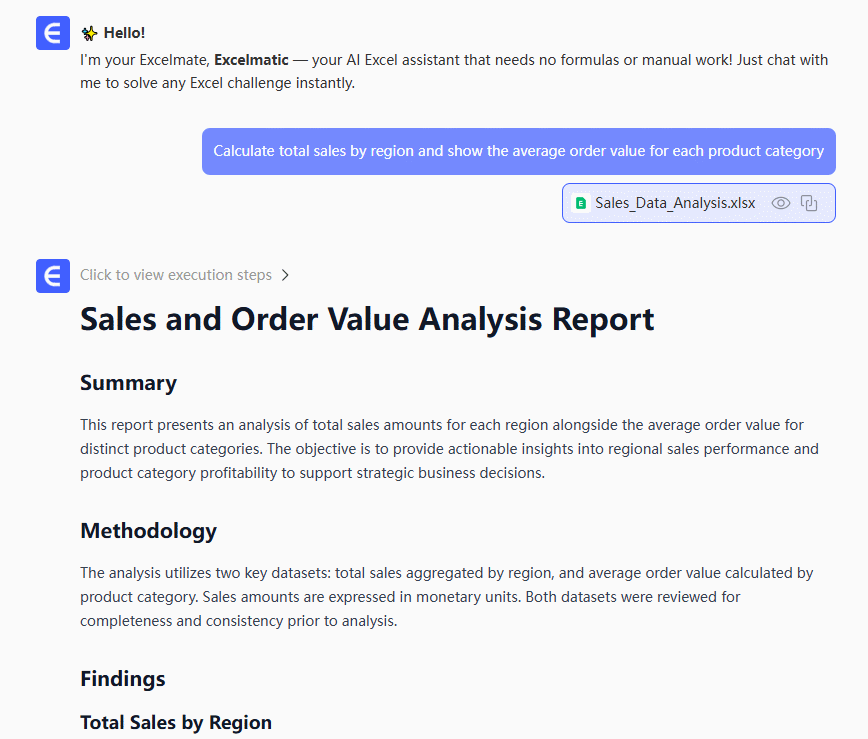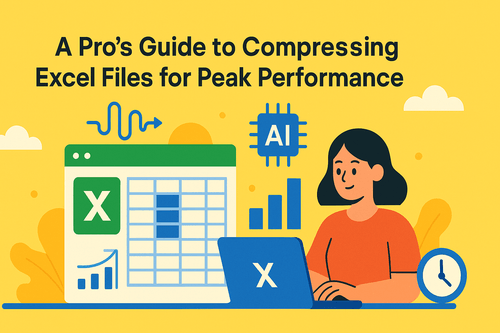Key Takeaways
- Manual Excel data cleaning is repetitive and error-prone, especially with complex datasets and multiple operations
- Technical solutions like Python require coding skills that most business users don't have
- Excelmatic's AI handles complex data transformations instantly with simple language commands, no technical expertise needed
- Combining Excel knowledge with Excelmatic provides the fastest workflow for accurate, well-structured data analysis
There are several ways to clean and transform Excel data, ranging from manual methods within Excel to programmatic solutions and AI-powered tools like Excelmatic. While basic Excel functions can handle simple tasks, complex data preparation often requires multiple steps and technical expertise.
This article provides a comprehensive guide to Excel data transformation. We'll explore practical methods for data cleaning, calculations, formatting, and analysis, along with best practices to ensure your data remains accurate and actionable.
Understanding Data Transformation Challenges
Before diving into specific methods, it's important to recognize common data challenges that require transformation.
Common Excel data issues
Business users frequently encounter these data problems:
- Inconsistent formatting: Mixed date formats, inconsistent text casing
- Missing or duplicate data: Blank cells, repeated records
- Structural problems: Merged cells, multiple header rows
- Calculation needs: Complex formulas across multiple columns
- Data validation: Identifying outliers or incorrect values
The Different Ways to Transform Excel Data
Cleaning and transforming Excel data can be done in several ways depending on your comfort level and the complexity of your tasks.
1. The AI-Powered Way: Using Excelmatic
The fastest and most intuitive way to handle data transformations is with Excelmatic. This approach eliminates manual steps and the need for coding, making it perfect for business users of all skill levels.

The process is remarkably simple:
- Upload your Excel file to Excelmatic.
- State your request in simple terms.
For data cleaning, you could ask:
Clean this data: remove empty rows, standardize the date format, and fix any inconsistent text casing.

For calculations and analysis:
Calculate total sales by region and show the average order value for each product category.

For data transformation:
Create a new column that combines first name and last name, and calculate the age from birth dates.

Excelmatic handles the entire process instantly—reading your data, understanding your request, and providing the transformed results for download.
Why this is better for business users:
- Effortless: No navigating menus or writing code.
- Fast: Converts multiple sheets in seconds with a single command.
- Intelligent: Automatically handles common pitfalls like encoding and ensures data integrity.
- No-Code: Accessible to everyone, regardless of technical expertise.
2. Manual Techniques using Excel Functions
The most direct way to transform data is using Excel's built-in functions and features. This method works well for simple, one-time transformations.
Basic data cleaning functions
- TRIM(): Remove extra spaces
- PROPER()/UPPER()/LOWER(): Standardize text casing
- CLEAN(): Remove non-printable characters
- Find and Replace: Bulk text replacements
Common transformation formulas
- Text combination:
=A2&" "&B2or=CONCATENATE(A2," ",B2) - Date calculations:
=DATEDIF(A2,TODAY(),"Y")for age calculation - Conditional logic:
=IF(C2>100,"High","Low") - Lookup operations:
=VLOOKUP(A2,D:E,2,FALSE)
Data analysis features
- Remove Duplicates: Data tab → Remove Duplicates
- Text to Columns: Data tab → Text to Columns for splitting data
- Conditional Formatting: Home tab → Conditional Formatting for visual analysis
While these manual methods work, they become time-consuming with complex datasets and require formula expertise.
3. Programmatic Approaches with Python
For advanced users, Python provides powerful data transformation capabilities through libraries like pandas.
Sample Python code for data cleaning:
import pandas as pd
# Load Excel file
df = pd.read_excel('data.xlsx')
# Basic cleaning operations
df_clean = (df
.dropna() # Remove empty rows
.drop_duplicates() # Remove duplicates
.rename(columns=lambda x: x.strip().lower()) # Clean column names
)
# Save cleaned data
df_clean.to_excel('cleaned_data.xlsx', index=False)
While powerful, this method requires Python knowledge and development environment setup. Excelmatic provides similar automation through simple language commands.
4. Power Query for Advanced Transformations
Excel's Power Query (Get & Transform Data) offers robust data transformation capabilities without coding.
Common Power Query operations:
- Merge queries from multiple sources
- Pivot and unpivot data structures
- Group and aggregate data
- Conditional columns and custom calculations
Access through: Data tab → Get Data → From Other Sources
5. Third-party Excel Add-ins
Various commercial add-ins provide enhanced data transformation capabilities:
- Kutools for Excel: Extended functionality suite
- Ablebits: Data cleaning and manipulation tools
- Professor Excel Tools: Productivity enhancements
Real-World Transformation Examples
Example 1: Sales Data Preparation
- Before: Raw sales data with inconsistent formatting and missing values
- Excellantic Command: "Clean this sales data: fill missing values with zero, standardize product names, and calculate total revenue per transaction"
- Result: Clean, analysis-ready dataset
Example 2: Customer Database Enhancement
- Before: Customer list with separate name fields and various date formats
- Excellantic Command: "Combine first and last name columns, standardize date formats, and flag customers with incomplete information"
- Result: Unified customer database with validation flags
Example 3: Financial Report Generation
- Before: Raw transaction data across multiple sheets
- Excellantic Command: "Consolidate all transaction sheets, categorize expenses, and calculate monthly totals by category"
- Result: Comprehensive financial summary report
Performance Comparison
| Method | Best For | Speed | DEase of Use | Automation Level |
|---|---|---|---|---|
| Excelmatic (AI) | Quick, complex transformations | Very Fast | Very Easy | Very High |
| Excel Manual | Simple, one-time tasks | Moderate | Moderate | Low |
| Power Query | Repeatable complex transformations | Fast | Moderate | High |
| Python | Large datasets & custom logic | Very Fast | Difficult | Very High |
| Excel Add-ins | Enhanced functionality within Excel | Fast | Easy | Medium |
Conclusion
Transforming Excel data is essential for accurate analysis and decision-making. While manual methods and traditional tools have their place, they often require technical expertise and significant time investment.
Excelmatic represents a breakthrough for business professionals, combining the power of advanced data transformation with the simplicity of natural language. By describing what you need in plain terms, you can accomplish complex data preparation tasks instantly—without formulas, coding, or technical overhead.
Whether you're cleaning customer data, preparing sales reports, or analyzing operational metrics, Excelmatic makes data transformation accessible to everyone.
Ready to transform how you work with Excel data?
Start using Excelmatic today and experience instant, AI-powered data preparation.
FAQ
What's the fastest way to clean messy Excel data?
For most business users, Excelmatic provides the fastest solution. Simply describe what needs cleaning (like "remove duplicates and fix date formats") and get instant results without manual work.
Can I automate complex calculations across multiple columns?
Yes, Excelmatic handles complex calculations with simple commands. Ask for things like "calculate growth percentages" or "create summary statistics" and get accurate results immediately.
How do I handle data from multiple Excel sheets?
Excelmatic can process data across multiple sheets with commands like "combine all sheets and remove duplicate records" or "calculate totals from each monthly sheet."
Is technical expertise required for data transformation?
With traditional methods, yes. But Excelmatic eliminates the need for technical skills—just describe what you need in plain language.
Can I transform data for specific analysis purposes?
Absolutely. Excelmatic understands analysis context. Commands like "prepare this data for sales analysis" or "format for dashboard visualization " yield appropriately structured results.






